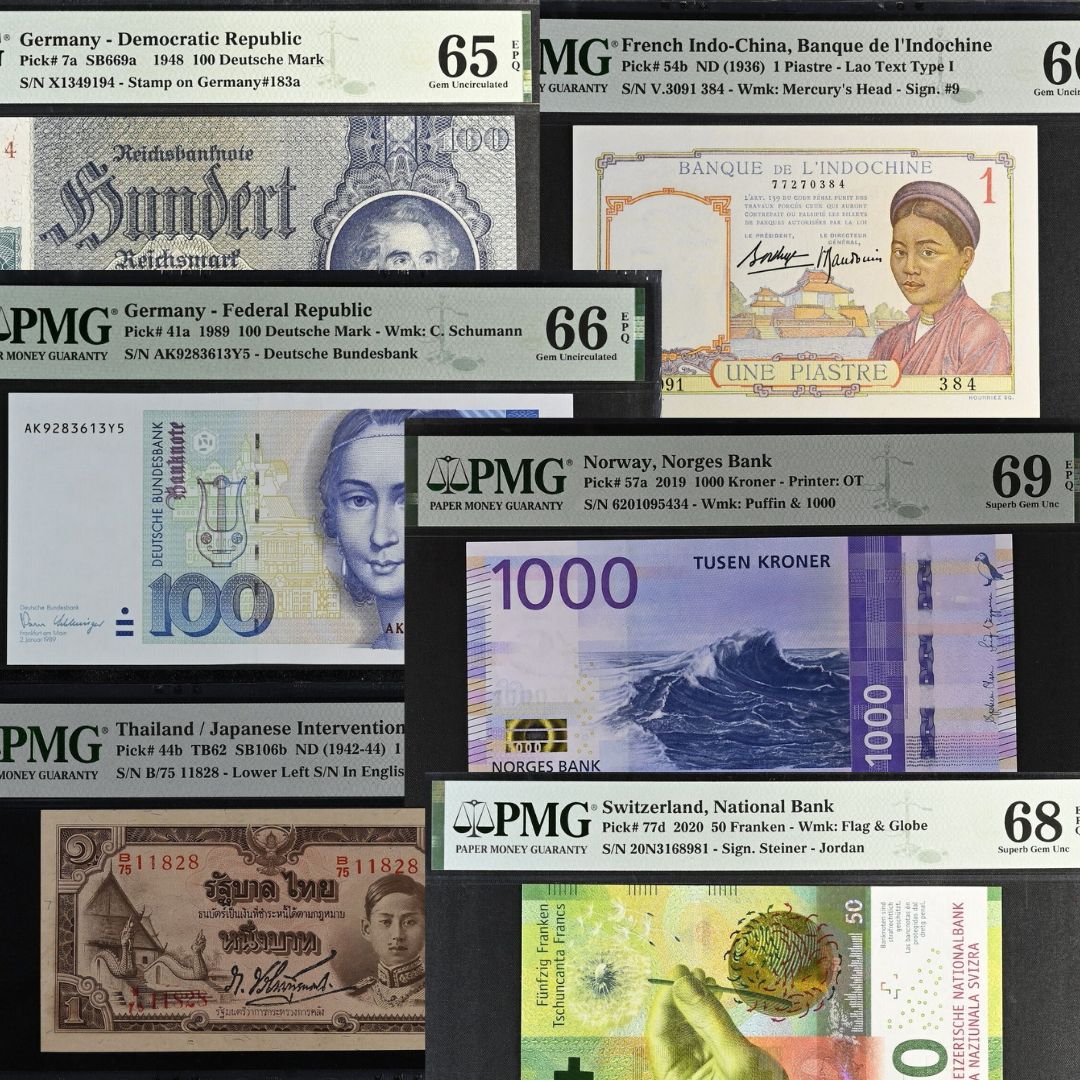PMG Definition in Banknote Collecting
PMG stands for Paper Money Guaranty — the leading third-party grading service dedicated to banknotes. It provides objective evaluations that certify a note's authenticity and condition.
The Role of Paper Money Guaranty (PMG)
Just like PSA in trading cards or NGC in coins, PMG sets the standard in the paper money world. Once a banknote is graded by PMG, it’s sealed in a secure holder with a tamper-proof label, increasing its trustworthiness in the marketplace.
Why PMG Grading Matters in Banknote Collecting
Trust and Authenticity in the Market
Let’s face it—counterfeits exist. PMG gives buyers peace of mind. When a note has that PMG seal, it means experts have verified it.
Enhancing Value with a PMG Grade
A PMG-graded note almost always sells at a premium. Whether you're flipping a note or holding it long-term, that little label can make a big difference.
The PMG Grading Scale Explained
Overview of PMG Grades (1 to 70)
PMG uses a 70-point scale:
-
70 = Perfect Uncirculated
-
1 = Poor/Heavily Damaged
What Makes a Banknote a PMG 70?
Perfect centering, flawless paper, no folds. Think of it like a museum-quality note—something even picky collectors admire.
Common PMG Grades and What They Mean
-
PMG 65–70: Gem Uncirculated
-
PMG 58–64: Choice AU
-
PMG 40–55: Extremely Fine to About Uncirculated
-
PMG 20–35: Fine to Very Fine
-
Below 20: Circulated, damaged, or torn
PMG Grading Process Step-by-Step
How Banknotes Are Submitted
You can submit directly through PMG (with membership) or go through a certified dealer. Notes are then reviewed by multiple graders.
Evaluation Criteria Used by PMG
-
Print clarity
-
Color brightness
-
Fold marks
-
Margins
-
Paper thickness
Security Features Checked
Watermarks, embedded threads, and security inks are carefully reviewed to ensure authenticity.
Paper Quality and Printing Alignment
Even the slightest misalignment or handling damage can knock off a few grade points!
PMG Label and Holder Breakdown
What’s on the PMG Label?
Each graded note gets a label with:
-
Grade
-
Serial number
-
Country
-
Year
-
Pick number (catalog reference)
How the PMG Holder Protects Value
These holders are sealed shut and resistant to water and air. Plus, they display well — like a trophy case for your collectible!
Top Reasons to Choose PMG Grading
Provenance and Collectibility
PMG certification often becomes part of a note’s story. Serious collectors look for graded notes because it makes future trading easier.
Global Recognition and Resale Value
PMG is known worldwide. Want to sell on eBay, Heritage, or MA-Shops? PMG-graded notes move faster and at better prices.
PMG vs Other Banknote Grading Services
Comparison with PCGS Currency
While PCGS is also respected, PMG tends to dominate in international markets. Their pop reports and consistency make them a top choice.
Why Collectors Trust PMG
They’ve graded over 10 million banknotes, and their graders are among the most experienced in the world.
How to Submit a Banknote to PMG
Joining PMG or Submitting Through a Dealer
You can:
-
Join as a member
-
Use an authorized PMG dealer
Shipping and Turnaround Time
Expect about 2–4 weeks from submission to return depending on tier.
PMG Fees and Pricing Tiers
Basic Fee Structure
Starts around $20–30 per note, depending on declared value.
Factors Affecting Grading Cost
-
Express service adds premium
-
High-value notes cost more to grade
-
Bulk submissions get discounts
Common Myths About PMG Grading
“Only Rare Notes Should Be Graded”
False! Even modern notes can benefit if they’re pristine or rare in print run.
“All Graded Notes Are Overpriced”
Not true. Grading adds real value when used properly — especially for resale.
PMG Pop Report and Population Data
How to Use PMG Population Reports
Use them to see how rare your note is in each grade. Think of it like a supply indicator for collectors.
Evaluating Rarity Through Pop Stats
If only 5 notes exist in PMG 66, that’s a sign yours is something special.
Market Trends of PMG-Graded Notes
Recent Auction Results
Notes graded PMG 66 or higher are consistently breaking auction records, especially in niche markets like Thailand, Vietnam, or rare errors.
Investment Insights
PMG-graded notes are increasingly being seen as alternative investments, like fine art or vintage watches.
Tips for New Collectors
Choosing Notes to Grade
Start with:
-
Error notes
-
Low serial numbers
-
Limited edition releases
Avoiding Counterfeit Submissions
Use UV lights, watermarks, and banknote reference books before submitting. Avoid dodgy dealers.
Final Thoughts on PMG Meaning and Value
PMG grading isn't just about assigning a number — it’s about protecting your investment, building trust, and elevating your collection. Whether you're new or seasoned, PMG adds legitimacy and market appeal to your paper money.
FAQs
1. What does PMG stand for in banknotes?
PMG means Paper Money Guaranty, a third-party grading company for banknotes.
2. Is PMG grading worth it?
Yes. It increases a note’s value, protects it, and makes it easier to sell.
3. How do I know if my note is worth grading?
If it’s rare, uncirculated, or has unique features (low serials, errors), it's likely worth grading.
4. How long does PMG grading take?
Turnaround varies, but usually 2–4 weeks depending on service level.
5. What’s the highest PMG grade?
PMG 70, which represents a perfect, flawless note.





